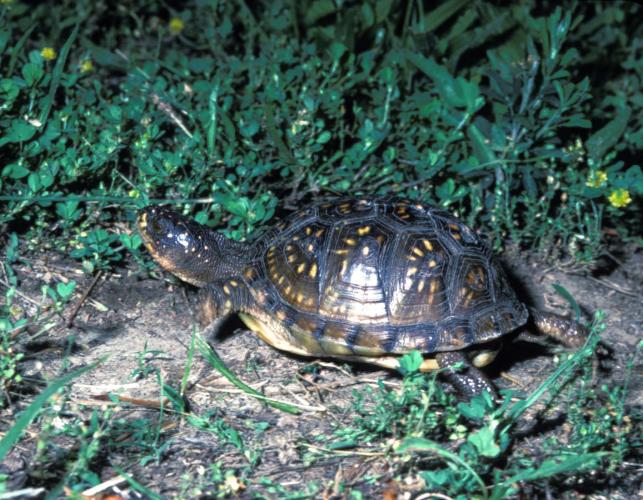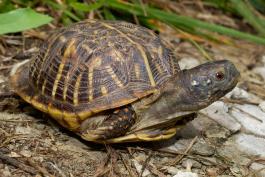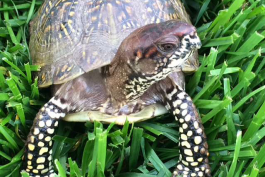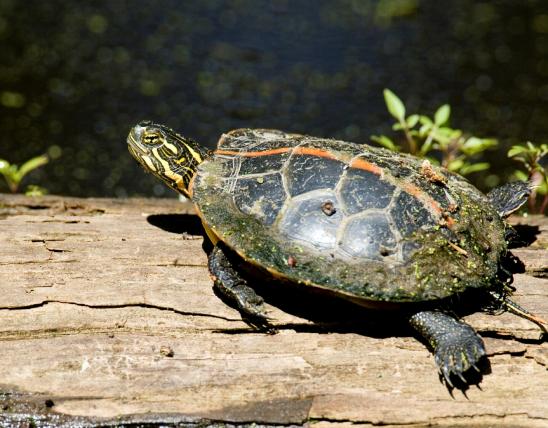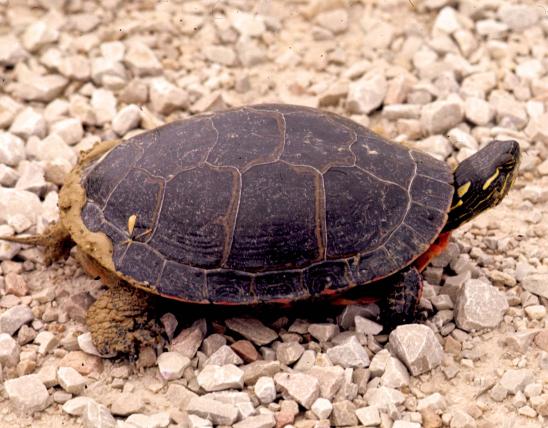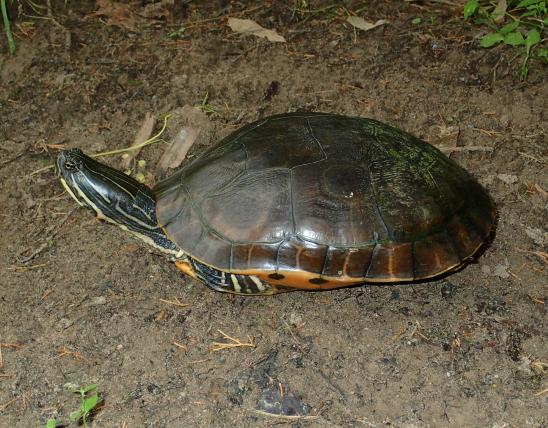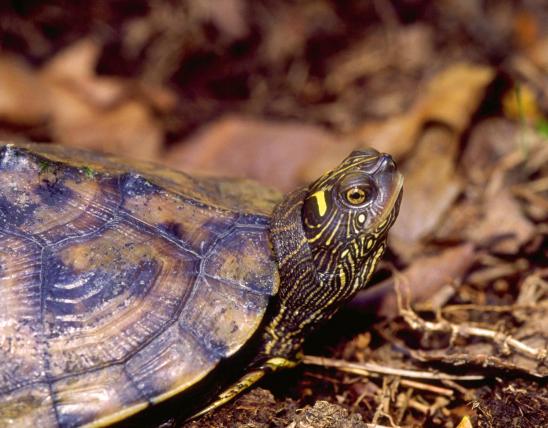
The ornate box turtle is a small, land-dwelling turtle with a domed upper shell (carapace) and hinged lower shell (plastron) that allows it to close its lower shell. The carapace has a flattened appearance along the dorsal surface and normally has no ridge. The carapace is brown to nearly black with numerous yellow lines radiating from the center of each scute (shell scale). A yellow stripe running along the midline of the carapace is often present. The plastron is dark brown with bold light lines. Across the plastron, just above the center, is a flexible hinge that allows the front and rear of the lower shell to press up against the upper shell, enabling the head, tail, and all four limbs to be protected from harm.
The exposed skin is grayish brown, with faint yellow or orange-yellow spots or blotches; the chin and upper jaw are yellow or yellow green. There are normally 4 toes on each hind limb.
Adult male ornate box turtles are slightly smaller than females and have a concave area in the center of their plastron, an enlarged and inward-facing first toe of the hind limbs, and red eyes. The eyes of females are yellow brown.
Similar species: The three-toed box turtle (T. carolina triunguis) usually has 3 toes on each hind leg, has a ridge along the center of the top shell, and the top shell is usually olive or olive brown with faint yellow or orange lines radiating from the center of each plate. It is more of a woodland species than the ornate box turtle and is found statewide except for extreme northern and northwestern counties.
In Missouri's easternmost counties, along the Mississippi River, a sister subspecies of the three-toed box turtle may occur; this is the eastern box turtle (T. c. carolina). Like the three-toed subspecies, they have a ridge along the center of the top shell. However, they typically have a more ornate carapace, with radiating yellow or orange marks; dark smudges on the plastron; and usually 4 toes (sometimes 3) on the hind limbs. If you're near the Mississippi River, the absence of the ridge on the top shell, and the bold light lines on the lower shell, may be the best way to recognize an ornate box turtle.
Adult upper shell length: 4½–5 inches; occasionally to 6 inches.

Statewide, except for the southeastern corner of the state; it is more common in the northern and western parts of Missouri, where grassland habitats historically predominated.
Habitat and Conservation
Ornate box turtles are considered a prairie species, living where there is a mixture of prairie grasses and forbs. They will also live in open woodlands, rocky glades, and farm fields in former native prairie regions. In Missouri, ornate box turtles are active between late March and mid-October.
The typical daily routine for an ornate box turtle usually begins with a short period of basking soon after sunrise, followed by a period of foraging for food, a rest period during the heat of the day, and a short feeding session before resting at night. One study showed that they are active 20 percent of the day and inactive 80 percent. When inactive, ornate box turtles will shelter in clumps of grass, bury themselves in loose soil or sand, or enter burrows made by other animals.
During the hot, dry days of mid-to-late summer, these turtles are generally inactive but will appear in numbers after a heavy rain. They may use the shallow water and mud of prairie wetlands during the hottest part of the summer.
In winter, this species escapes the cold by burrowing down below the frost line, which may be 18 inches or more; those that take shelter in wooded areas may not burrow as deeply. In open native prairie, the overwintering burrows may be nearly 30 inches deep. Ornate box turtles that overwinter in open grasslands have been known to congregate in brushy areas, such as under blackberry bushes.
Food
Ornate box turtles mostly eat insects, with grasshoppers, crickets, beetles, and caterpillars composing nearly 90 percent of their diet. Earthworms are often eaten, too, especially in the spring. Fruits such as mulberries, wild strawberries, and dogwood fruits are also a part of their diet.
Status
The future health of Missouri’s population of ornate box turtles is of concern. Turtles have been generally declining statewide, mainly due to habitat destruction and fragmentation. Due to a lack of extensive movement of this species within a given area, habitat destruction and fragmentation can reduce the genetic viability of this species and other prairie animals. Ill-timed managed prairie burnings, road mortality, and illegal collecting also can reduce population numbers.
Missouri's subspecies of ornate box turtle is the subspecies Terrapene ornata ornata, which is officially called the plains box turtle. The other North American subspecies, the desert box turtle (T. o. luteola), occurs only in the desert southwest. The two might not be different enough to be considered separate subspecies. Also, Missourians are most familiar with the common name "ornate box turtle," so we retain it here.
Life Cycle
Ornate box turtles become active in late March.
Courtship and mating are most common in the spring; it tapers off in summer and can resume in early autumn. Nesting normally occurs between mid-May and mid-June. The female lays eggs in an exposed area with loose soil or sand, digging a flask-shaped hole with her hind limbs and depositing eggs at the bottom. Nest burrows are 1–3 inches deep. A clutch is usually 2–8 eggs, which hatch 2–3 months later. Most females will produce one clutch of eggs per season, but up to a third of adult females may lay a second clutch.
Males become mature at about 8–9 years of age, and females become mature at around 10–11 years of age. In general, most ornate box turtles likely live 30 years, with a few living up to 50 years.
Around the middle of October, box turtles dig into leaf litter and soil and go dormant to survive winter.
Human Connections
Of all the reptiles, turtles are the most admired by humans for their symbolic characteristics of slow, steady progress, longevity, and resilience as well as for their unique body form.
Prairie conservation is vital for this turtle's survival. This species is closely connected to native grassland habitats, so people must continue our efforts to protect and increase the availability of native tallgrass prairie in Missouri. The periodic burning of native tallgrass prairies and savannas has become a normal management practice. However, if prescribed burning is scheduled during the active season of ornate box turtles, the turtles are sure to be killed. These reptiles cannot outrun a prairie fire. Such fires need to be scheduled in late fall and early winter to protect this species and other prairie-dwelling wildlife.
Huge numbers of box turtles are killed on roads and highways each year in Missouri. A 29-year study documented a noticeable decline in numbers due to road mortality along a stretch of highway during late May and early June. Follow the speed limit, avoid tailgating, and keep your eyes on the road.
Both species of Missouri’s native box turtles need to be protected from illegal collecting for the worldwide pet trade. Fortunately, the Missouri Department of Conservation has protected the box turtle from being collected and sold as pets.
Many box turtles are captured by people on weekend outings and taken home to be kept as a pet. Such captive conditions are in direct conflict with the biological needs of these turtles; they may slowly starve to death or grow abnormal shells, claws, and jaws if not maintained and cared for correctly. These reptiles are an interesting part of outdoor Missouri and should not be kept in captivity.
Ecosystem Connections
Even though adult box turtles are defended by their shells, the eggs and young provide food for many predators. Hatchlings are only about 1 inch long and are especially vulnerable. Freshly laid eggs of ornate box turtles are often eaten by raccoons, skunks, and badgers.
The three-toed box turtle and the ornate box turtle have been found living in the same vicinity in a number of Missouri counties. In areas where they live in close proximity, they appear to select different microhabitats based on each species' needs for feeding, basking, estivation, and overwintering. Ornate box turtles, for instance, eat mostly insects, while three-toed box turtles eat mostly plant matter. Ornate box turtles use open prairie sites, while three-toed box turtles spend most of their time in wooded areas. There is little overlap in their microhabitat selection, allowing them to coexist with little competition.
During one particular Kansas winter (1975), 56 dead ornate box turtles were found aboveground with their head and forelimbs eaten. Apparently, many of the turtles had gone into overwinter dormancy while ill, and they died in their burrows and were subsequently dug up and eaten by coyotes or badgers once the flesh began to rot. Live and apparently healthy box turtles were found in the same area.
The ornate box turtle is a member of family Emydidae (the pond and box turtle family). This is one of the largest families of living turtles in the world. It comprises 12 genera, containing 52 species. In general, turtles in this family are small to medium sized and are adapted to a variety of habitats. This family includes several colorful species. Although the majority of species are aquatic (such as the eastern river cooter, red-eared slider, and the painted and map turtles), several kinds are either semiaquatic or have taken to life on land (for example, the box turtles). In Missouri, this family is represented by 7 genera with a total of 11 species and 1 additional subspecies.




